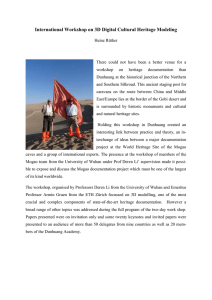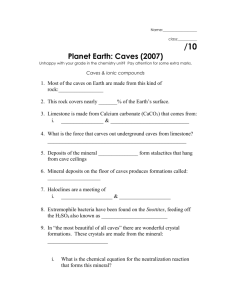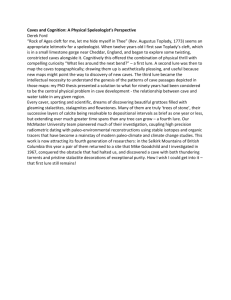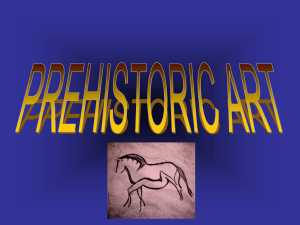FROM DIGITAL MOGAO CAVES TO DIGITAL CHI LIN NUNNERY
advertisement
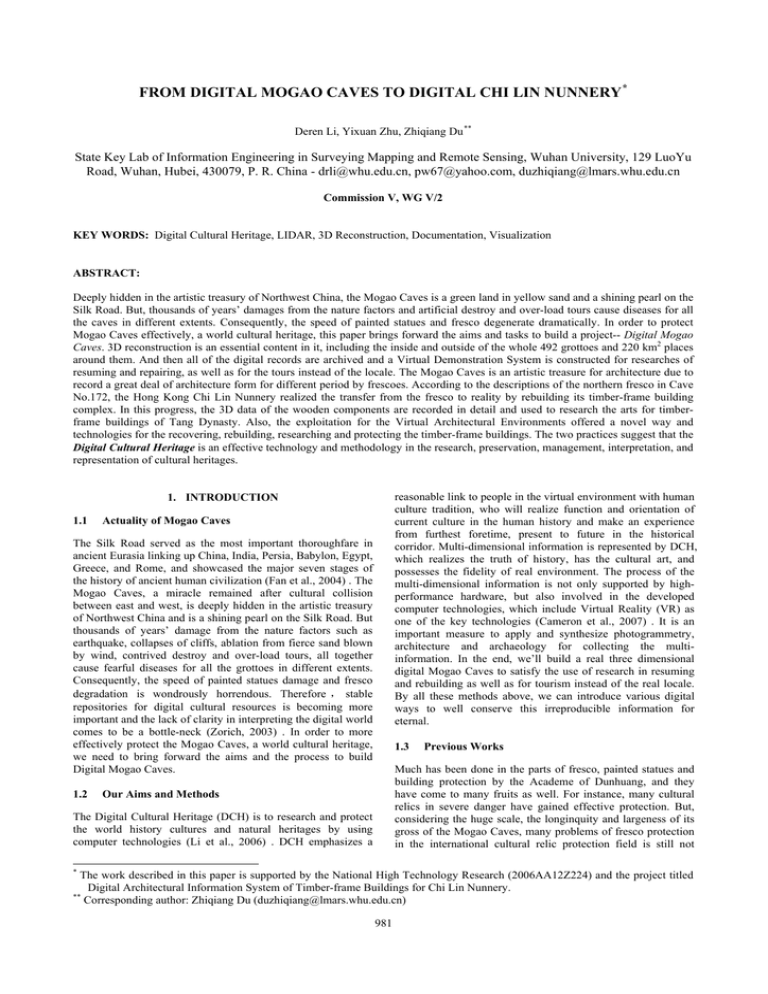
FROM DIGITAL MOGAO CAVES TO DIGITAL CHI LIN NUNNERY * Deren Li, Yixuan Zhu, Zhiqiang Du ** State Key Lab of Information Engineering in Surveying Mapping and Remote Sensing, Wuhan University, 129 LuoYu Road, Wuhan, Hubei, 430079, P. R. China - drli@whu.edu.cn, pw67@yahoo.com, duzhiqiang@lmars.whu.edu.cn Commission V, WG V/2 KEY WORDS: Digital Cultural Heritage, LIDAR, 3D Reconstruction, Documentation, Visualization ABSTRACT: Deeply hidden in the artistic treasury of Northwest China, the Mogao Caves is a green land in yellow sand and a shining pearl on the Silk Road. But, thousands of years’ damages from the nature factors and artificial destroy and over-load tours cause diseases for all the caves in different extents. Consequently, the speed of painted statues and fresco degenerate dramatically. In order to protect Mogao Caves effectively, a world cultural heritage, this paper brings forward the aims and tasks to build a project-- Digital Mogao Caves. 3D reconstruction is an essential content in it, including the inside and outside of the whole 492 grottoes and 220 km2 places around them. And then all of the digital records are archived and a Virtual Demonstration System is constructed for researches of resuming and repairing, as well as for the tours instead of the locale. The Mogao Caves is an artistic treasure for architecture due to record a great deal of architecture form for different period by frescoes. According to the descriptions of the northern fresco in Cave No.172, the Hong Kong Chi Lin Nunnery realized the transfer from the fresco to reality by rebuilding its timber-frame building complex. In this progress, the 3D data of the wooden components are recorded in detail and used to research the arts for timberframe buildings of Tang Dynasty. Also, the exploitation for the Virtual Architectural Environments offered a novel way and technologies for the recovering, rebuilding, researching and protecting the timber-frame buildings. The two practices suggest that the Digital Cultural Heritage is an effective technology and methodology in the research, preservation, management, interpretation, and representation of cultural heritages. reasonable link to people in the virtual environment with human culture tradition, who will realize function and orientation of current culture in the human history and make an experience from furthest foretime, present to future in the historical corridor. Multi-dimensional information is represented by DCH, which realizes the truth of history, has the cultural art, and possesses the fidelity of real environment. The process of the multi-dimensional information is not only supported by highperformance hardware, but also involved in the developed computer technologies, which include Virtual Reality (VR) as one of the key technologies (Cameron et al., 2007) . It is an important measure to apply and synthesize photogrammetry, architecture and archaeology for collecting the multiinformation. In the end, we’ll build a real three dimensional digital Mogao Caves to satisfy the use of research in resuming and rebuilding as well as for tourism instead of the real locale. By all these methods above, we can introduce various digital ways to well conserve this irreproducible information for eternal. 1. INTRODUCTION 1.1 Actuality of Mogao Caves The Silk Road served as the most important thoroughfare in ancient Eurasia linking up China, India, Persia, Babylon, Egypt, Greece, and Rome, and showcased the major seven stages of the history of ancient human civilization (Fan et al., 2004) . The Mogao Caves, a miracle remained after cultural collision between east and west, is deeply hidden in the artistic treasury of Northwest China and is a shining pearl on the Silk Road. But thousands of years’ damage from the nature factors such as earthquake, collapses of cliffs, ablation from fierce sand blown by wind, contrived destroy and over-load tours, all together cause fearful diseases for all the grottoes in different extents. Consequently, the speed of painted statues damage and fresco degradation is wondrously horrendous. Therefore , stable repositories for digital cultural resources is becoming more important and the lack of clarity in interpreting the digital world comes to be a bottle-neck (Zorich, 2003) . In order to more effectively protect the Mogao Caves, a world cultural heritage, we need to bring forward the aims and the process to build Digital Mogao Caves. 1.2 1.3 Previous Works Much has been done in the parts of fresco, painted statues and building protection by the Academe of Dunhuang, and they have come to many fruits as well. For instance, many cultural relics in severe danger have gained effective protection. But, considering the huge scale, the longinquity and largeness of its gross of the Mogao Caves, many problems of fresco protection in the international cultural relic protection field is still not Our Aims and Methods The Digital Cultural Heritage (DCH) is to research and protect the world history cultures and natural heritages by using computer technologies (Li et al., 2006) . DCH emphasizes a * The work described in this paper is supported by the National High Technology Research (2006AA12Z224) and the project titled Digital Architectural Information System of Timber-frame Buildings for Chi Lin Nunnery. ** Corresponding author: Zhiqiang Du (duzhiqiang@lmars.whu.edu.cn) 981 The International Archives of the Photogrammetry, Remote Sensing and Spatial Information Sciences. Vol. XXXVII. Part B5. Beijing 2008 solved. In our work frame, firstly, a real 3D reconstruction will be done including the inside and outside for the whole 492 caves and 220 km2 places around them, to construct a general digital record and virtual demonstration system for researches of resume and rebuild, as well as for the tours instead of the locale. Secondly, research on the chromatic recovering and rebuilding for the fresco will be implemented. Through studying the history of the evolvement and development of fresco colours, the methodologies of digital image processing are used to recover the fresco’s real colours. Thirdly, in the virtual environment, the 3D Holographic Laser Projection helps us to realize the 3D interpretation of the histories in Dunhuang for the culture inherence and communication. According to the workflow above, this cultural relic will be conserved precisely, scientifically and forever. More importantly, it is possible that the illustrious history for more than one thousand years of the Mogao Caves will recur in a virtual world. 2.2 2. DATA ACQUIRING 2.1 Control Surveying The control survey is introduced, in one hand, all the absolute coordinates with high precision is acquired, and it can also build up a conversion relationship from the relative coordinates acquired in ways below to their geodesic ones. It covers two parts, one is traverse survey, and the other is photo control point survey on different sides of nine-stored Mogao cave. During traverse surveying, three traverses namely the traverse A, B and C are laid down and they are annexed traverse totally. Traverse A is composed of 4 traverse points: GPS23, A1, A2, and GPS15;traverse B is made up of 5 traverse points: A1, B1, B2, B3, and A2 ; and traverse C consists of 8 traverse points: GPS23, C1, C2, C3, C4, C5, C6, and GPS15. Multi-viewpoint Stereo Photogrammetry Stereo photogrammetry is an effective method of acquiring scene information and has the significant advantages in concentrating the objects’ 3D shape and texture. Therefore, for some special applications, such as those requiring high precision in dimensions (both in shape and position reconstruction dimensions, and in texture mapping dimensions) and high quality in vision experience of objects’ appearance, e.g. digital archives and 3D reconstruction of ancient buildings, grottoes or mural, this method has many prevailing advantages. The principle of fixed-baseline stereo photogrammetry is based on the theory of aero-photography measurement and computer vision (Hartley et al., 2000; Li et al., 1992) . Firstly, spatial resection method is used to calculate the intrinsic and extrinsic parameters of each camera (Gao et al., 2007) . Secondly, spatial forward intersection can be used to calculate the 3D coordinates of corresponding points between the stereo images. Lastly, 3D model can be archived by automatic triangulation reconstruction or by human-computer interaction from the point clouds, after rectifying the image and its rectified dense matching. Of course, wire frame model can be directly obtained by human-computer interaction, i.e., measuring and modelling, and owing to the vision based on their process, the dimension and position of the texture combined with its mapping are in high precision. Figure 2. (a) The image from the left camera; (b) the image from the right camera 2.3 Laser Scanning Recently, laser scanning technology has been widely used in the model reconstruction for ancient buildings (Bonora et al., 2005) . It can acquire large amount of points with high density from the surface of an object. However, it causes the problem in the later processing, such as triangulation, smoothing. In order to solve the problems previously listed, a spherical projection based on triangulation algorithm is developed to process the data separated by scanning station. After each station’s point clouds are processed, they’re merged together. 1. Triangulation Because the points in a station can be seemed as one laser centre measured, around which a spherical space is given so that it can be consequently defined. Then the points are projected onto the sphere surface, and a closed triangulation based on the sphere surface is made. As the triangulation in sphere space is similar to 2-dimensional triangulation, the algorithm is easier and faster compared with the 3-dimensinal triangulation algorithm. After the spherical triangulation, the data are projected back to its real position with the triangulation structure reserved, based on which mesh object can be created easily. Figure 1. Traverse sketch Artificial mark points are distributed in the different sides of the nine-stored Mogao Cave (Cave No.96). Some of the outstanding points in the building are chosen as photo control points to be surveyed. After computation, measurement accuracy is better than ± 15mm required by the Digital Dunhuang Project. 982 The International Archives of the Photogrammetry, Remote Sensing and Spatial Information Sciences. Vol. XXXVII. Part B5. Beijing 2008 2. Smoothing After the triangulation, smoothing can be easily applied to the mesh objects. Two options can be used for smoothing, namely feature preserved smoothing and common smoothing (Attali et al., 2003) . 3. DATA PROCESSING 3.1 The Mogao Caves owns its characteristics which cause plenty of problems to our work. First of all, most of the immovable caves own an irregular shape with a lot of tiny apertures and sheltered places without visibility. And this particularity directly makes it more difficult to acquire its data even by the most flexible way of laser scanning. Thus much more work has to be done but hardly anything fruit returned. 3. Hole filling Because of the shelter of other objects and the scanning angle limit, there are lots of small holes in the mesh generated. The goal to fill a hole is to remove it from the mesh. 4. Decimating This step aims to reduce the number of points. Similar to the smoothing, decimating often reduces the accuracy of shape because it will remove some triangles in the mesh. Feature preserving decimating is used, which can reduce the amount of triangles with features of model well reserved. Secondly, after the acquiring work, the entire data amount arose even more difficulties for processing. For instance, even for a signal cave, with a scanning precision of 2mm, its whole data amounts to some 5 millions triangles, and the texture information is even more fruitful, which requires both a detailed recording with high accuracy and much relational information with geometric structure stored. 5. Model merging After filling a hole, the mesh object from difference scanning station should be merged into a whole. So the data needs to be transformed and put together. Sometime, there exist some small holes among the meshes and those duplicated triangles. By rewrapping the data with few editing can solve the problem. 2.4 Characteristics of the Mogao Caves Thirdly, a distinctive difference with a common object lays in its texture. All the fresco and painted statues on the wall can be treated as a rare book recording all the thousands of years’ culture collision and variance, based on which we can pick up all those beautiful stories plus the massive culture beyond. Thus, an especial requirement on the detail information and accuracy of the texture is rising up, which causes plenty of problems for our acquiring and processing. Multi-baseline Rotating Photogrammetry This method is introduced to acquire the image data of the ninestoried Mogao Cave, including the ground acquiring way and elevator acquiring. 3.2 Modelling Among the difficulties above, a lot of work has been done to deal with them in the processing process. For instance, towards the laser scanning data for modelling, a reasonable workflow to its construction process has been set up after fully considering the needs of the Mogao Caves. Briefly speaking, this process includes several main steps as following. Firstly, laser scanner has been used to acquire 3-D point cloud data by piece,then these pieces of data is joined together according to some position relationships. In this workflow, 11 stations with 5m interval between each two nearby are set at some 50m away from the nine-storied Mogao Cave. Then each station takes a rotated photographing of the building. Four ribbons are laid on the ground. While on the elevator, the same method is implied using 5 stations with 10m interval between. In order to gain its absolute size, plenty of controlling points given by the control surveying are laid both on the surface and around the building, which are used as controlling data for later photogrammetry processing. Also, a parallel photographing method is chosen to acquiring the image of the outside wall, whose length measures to be almost 1.6 km. Figure 4. The point cloud of Cave No.158 Figure 5. The grey model of Cave No.158 Figure 3. The sketch of multi-baseline rotating photogrammetry 983 The International Archives of the Photogrammetry, Remote Sensing and Spatial Information Sciences. Vol. XXXVII. Part B5. Beijing 2008 reconstruction, the whole designing frame is coming from the Tang Dynasty building group’s distribution concept and its construction technique in Cave No. 158 northern fresco of the Mogao Caves. Following this fresco, the Nunnery sets up three entrances, three overlaid doors plus one courtyard, in which many construction concepts such as layering, splitting, in Tang Dynasty are well adopted. Next, based on the reality of the corresponding cave, a processing work has been done for reducing its density or interpolating. And then its Triangle Irregular Net (TIN) model is built up based on the processed data. After adding materials onto the model, the 3D grey model is done. Lastly, just by mapping the texture a 3-D rendered model is easily obtained. 3.3 Texture Mapping In order to make a real three dimension model, texture mapping is an essential step, including how to get the object texture, how to store it and how to make perfect projection to the facade of 3D objects. Till now , there’s no some steady way to deal with all the problems in texture, what we need to do is to figure out a concrete way to deal with the huge texture data in Mogao Caves. Our process includes four main steps as following: Our missions are including three aspects through the 3D reconstruction the scene of Chi Lin Nunnery: (1) engineering inspection; (2) virtual assembling: the archives of all wooden components are established and helps us to research the architectural arts of timber-frame building; (3) virtual roaming: a virtual architectural environment is developed and it can meet the requirements of interactive query and exploration. 4.2 a) b) c) d) e) texture acquiring; geometrical correcting; colour correcting; automatic stitching; texture mapping. Data Acquiring Considering its complexity in construction as well as the precision needed, a set of methods is adopted such as the manual measuring, instrumental measuring, close-range photogrammetry, and Laser Scan. The manual way is still useful as it can easily record some attribute information and size of a component which can directly benefit the reconstruction work. And instrumental measuring refers to an indirect way for calculating and mapping, which mainly provides a huge amount of data for engineering process and supplemental measured objects. While the close-range photogrammetry helps us gain the surface and inner 3D measuring data of a complex object according to the client’s requirement. Meanwhile, Laser Scan is chosen for its main advantage that it can directly acquiring the 3D facade data of an object that owns detailed appearance. All the ways above is also compensatory to each other and after a combined work of them all the essential data is obtained with a high accuracy. Figure 6 illustrates the applications on a painted statue of Buddha from different steps, in the end we get a piece of texture which can be mapped directly onto the 3-D model. 4.3 Modelling of Wooden Components Based on the data acquired above, all the 3D modelling work for both the objects and the components is done by component. For instance, a complex part is separated into different components, whose 3D modelling work is respectively done. Figure 6. The whole 3D modelling process of a Buddha statue in Cave No.158: (a) the point cloud data; (b) TIN model; (c) grey model; (d) textured model 4. A TRANSFORMIING TO CHI LIN NUNNERY 4.1 Introduction and Our Missions The Digital Dunhuang is built not only for the Mogao Caves, but also for searching further value in related fields. For instance, after carefully studying the fresco, the rebuilding project of Hong Kong Chi Lin Nunnery realized a transformation from the fresco to reality. Figure 7. 3D models of the wooden components Chi Lin Nunnery in Hong Kong, founded in 1934, was completely rebuilt in 1998. Covering space of 30,000 square meters, Chi Lin Nunnery consists of twenty-four timber-frame buildings, architectural decorations, and plants. During the The scene is small and exquisite in Chi Lin Nunnery. The emphasis on modelling stands out the delicacy and accurate of timber-frame buildings in Tang style or decorations. In addition, 984 The International Archives of the Photogrammetry, Remote Sensing and Spatial Information Sciences. Vol. XXXVII. Part B5. Beijing 2008 Interface (API). Lastly, it can well meet the requirements of restoring ancient buildings and conserving historical documents (Du et al., 2006) . Thus, it benefits the tourism a lot not only for providing a flexible viewpoint but also for replacing the real one just limited to its own place. not only the appearance but also the inner structure of timberframe building needs to be presented to viewers. So 4 discrete LODs are used for an object; and their picked conditions and basic requirements are well considered. 4.4 Engineering Supervision Based on our database and the knowledge gained in Mogao caves, we’ve perfectly performed the engineering supervision on the reconstruction work. Computer supervision uses the modern surveying technique to supervise the ancient-style building works and a 3-D model database of all wooden components has been established. Compared with this, the traditional method of supervision uses measuring rods, calipers, etc., requiring a large area, significant time, and a lot of work plus efforts while can only cover partial locations. In details, our work covers two parts, namely the Single-component Supervision and Assembly Supervision. (a) Figure 10. (a) a snap of the 3D virtual scene; (b) a photo of the real scene (Du et al., 2006) 4.7 Virtual Assembly The study on virtual assembly for some complex part benefits the quality supervising and technology planning a lot in the construction process, like making collision detection. Moreover, it contributes to research the art and technologies of building assembly, which can separate a complex building structure into different detail levels and provide a more clear view about it. 5. CONCLUSION AND FUTURE WORK 5.1 Conclusion As is proved by facts and theories, Digital Cultural Heritage is the most effective way in researching, protecting and using of the cultural heritage. Under such circumstances as our cultural heritage is facing up with great difficulties, some essential methods to well protect our common fortune are in urgent need. Firstly, by the development of Laser Scanning and Virtual Reality, it is possible to build up a digital cultural heritage by using these tools to get accurate data and utilize it to keep any important information as well as to rebuild any mangled parts. Secondly, an on-line tourism can be set up to replace the real one for better and all-sided view, as well as let that real cultural heritage get less invisible damages. Lastly, based on the store of the multidimensional information about the cultural heritage in every detail, our database management system will offer convenient, agile and clipping information inquiring and searching. Our 3-D model owns more advantages, for example, the users can browse the breathing scene form multi-points, multi-paths and multi-angles alternant. Meanwhile, the multilanguage edition character , sound , real images and 3-D describes are also offered. Figure 9. Study on the archaic building art and technologies 4.6 Significance This transformation work brings up its significance in many ways. In the rebuilding process, the 3D data of the timber-frame components acquired in real time are used to make the scientific engineering supervision on its work and a real 3D data records have been taken for all the timber-frame components, therefore digitally recurring the constructing arts for timber-frame buildings of Tang Dynasty. And it also benefits us a lot in the future study about the archaic arts and crafts. Meanwhile, the exploitation for virtual building environment has provided new production and technical ways in the recovering, rebuilding, researching and protecting the timber-frame buildings. Thus, besides the real Chi Lin Nunnery, a 3D digitalized Chi Lin Nunnery will be improved to be a sensitive way in the future as it can last out forever for all human beings. It could always well keep the artistic and academic worth for further discovering, and we can easily hold this all as our eternal treasure. Figure 8. Assembling Checking on Computer: when main hall was assembled on computer, a mistake of design was found. Two components, whose sizes are 5.85m*0.29m*0.20m and 10.40m*0.48m*0.34m, were found unable to join into each other. 4.5 (b) Virtual Roaming A virtual environment system is then built up based on the database with integrate 3D information about the timber-frame components. It owns three main characteristics. Firstly, it well represents the meaning of Chinese culture and arts of timberframe buildings. Secondly, it can break through the limitation of special field by providing flexible Application Program 985 The International Archives of the Photogrammetry, Remote Sensing and Spatial Information Sciences. Vol. XXXVII. Part B5. Beijing 2008 5.2 ANCIENT BUILDINGS: A STUDY FOR S. M. MAGGIORE IN BERGAMO. In: proceedings of CIPA 2005 20th International Symposium: International Cooperation To Save The World's Cultural Heritage, Turin, Italy. Future work While we’re looking forward, it is clear that the fully use of present techniques in information science will greatly benefit our work in cultural protection and digitalization. Though we’re meeting such a difficult historical task as cultural heritage protection, we believe that all these techniques will rapidly improve our country’s technical level in this field. Also, we need to lucubrate in the VR and some other front edge techniques in order to create some software and hardware condition according with the situation of our own. Then we can organically combine it with our practice in cultural heritage protection, building up effective ways for dissemination of cultural relic knowledge and diffusion of its culture beyond. Meanwhile, more research in the chromatic recovering and rebuilding for the fresco will be implemented. Through studying the history of the evolvement and development of fresco colours, the methodologies of digital image processing are used to recover the fresco’s real colours. What’s more, in the virtual environment, the 3D Holographic Laser Projection will be used to realize the 3D interpretation of the histories in Dunhuang for the culture inherence and communication. Based on the work above, this cultural heritage will be conserved precisely, scientifically and forever. More importantly, it is possible that the illustrious history for more than one thousand years of the Mogao Caves will recur to a virtual world. Cameron, F. and Kenderdine, S., 2007. Theorizing Digital Cultural Heritage: A Critical Discourse. Media in Transition Series. The MIT Press, Cambridge, MA, USA, 528 pp. Du, Z., Li, D., Zhu, Y. and Zhu, Q., 2006. 3D GIS-based reconstruction and visualization of timber-frame building cluster. Xitong Fangzhen Xuebao / Journal of System Simulation, 18(7), pp. 1884-1889. Fan, J. and Wu, J., 2004. Dunhuang Grottoes. China Travel & Tourism Press, Beijing, 119 pp. Gao, Z., Zhong, S. and Liu, Y., 2007. Automatic Cal ibration of Binocular Vision System in Coded Control Field. Geomatics and Information Science of Wuhan University, 32(10), pp. 936939. Hartley, R. and Zissman, A., 2000. Multiple View Geometry in Computer Vision. Cambridge University Press, Lundon, UK. Li, D. and Zheng, Z., 1992. Analytical Photogrammetry. Surveying and Mapping Press, Beijing, China. REFERENCES Li, D., Zhu, Y., Du, Z. and Hong, T., 2006. Virtual Tang-style Timber-frame Building Complex. In: the proceedings of 16th International Conference on Artificial Reality and Telexistence, Hangzhou, China, Vol.LNCS v4282, pp. 880-888. Attali, D., Boissonnat, J. and Lieutier, A., 2003. Complexity of the Delaunay Triangulation of Points on Surfaces: the Smooth Case. In: Proceedings of 19th ACM Symposium on Computational Geometry, San-Diego, California, USA., pp. 201-210. Zorich, D.M., 2003. A survey of digital cultural heritage initiatives and their sustainability concerns, Council on Library and Information Resources, Washington, D.C. Bonora, V., Colombo, L. and Marana, B., 2005. LASER TECHNOLOGY FOR CROSS-SECTION SURVEY IN 986



